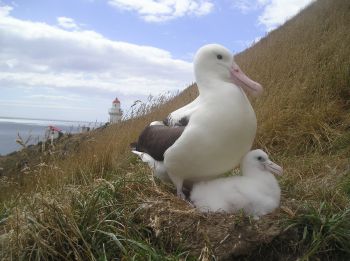The paper's abstract follows:
CASE HISTORY: In February 2004, two Northern Royal albatross chicks aged 20 and 25 days old were presented for necropsy. Both chicks had been hand-fed in situ at a breeding colony, from 2-3 days post-hatch. The hand-rearing diet consisted of boneless hoki fillets (Macraronus novaezelandiae), electrolytes, and sooty shearwater (Puffinus griseus) proventricular oil obtained as a by-product of cultural harvest.
PATHOLOGICAL FINDINGS: Routine necropsies on the affected chicks revealed many bones were soft and easily bent. Radiography and histopathology revealed decreased bone density, pathological fractures, and extensive remodelling suggestive of fibrous osteodystrophy.
DIAGNOSIS: Nutritional secondary hyperparathyroidism, resulting from an imbalance in the dietary Ca:P ratio.
CLINICAL RELEVANCE: The imbalance in the dietary Ca:P ratio was a result of feeding deboned and eviscerated fish. This investigation also highlighted potential health risks associated with the practice of feeding stored rancid proventricular oil, including the destruction of fat-soluble vitamins. It is therefore possible that oxidative degradation of vitamin D may have contributed to the development of nutritional secondary hyperparathyroidism.
Subsequently, dietary recommendations for supplementary feeding of orphaned Northern Royal albatross chicks include the feeding of whole human-grade fish with an appropriate Ca:P ratio, and the exclusion of proventricular oil. These cases highlight the need for scientific input into wildlife conservation projects, as lack of appropriate nutritional advice resulted in the feeding of a nutritionally inadequate diet. Following the recommended changes in diet, no further cases of osteodystrophy have been diagnosed in hand-raised chicks in the albatross colony.
Reference:
Morgan, K.J., Alley, M.R., Gartrell, B.D., Thompson, K.G. & Perriman, L. 2011. Fibrous osteodystrophy in two Northern Royal Albatross chicks (Diomedea sanfordi). New Zealand Veterinary Journal 59: 248-252.

John Cooper, ACAP Information Officer, 16 September 2011

 English
English  Français
Français  Español
Español